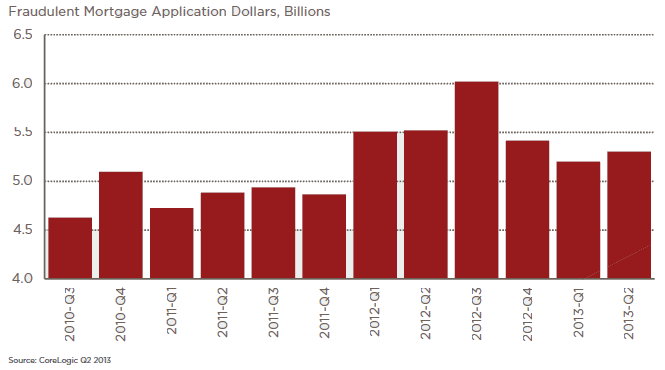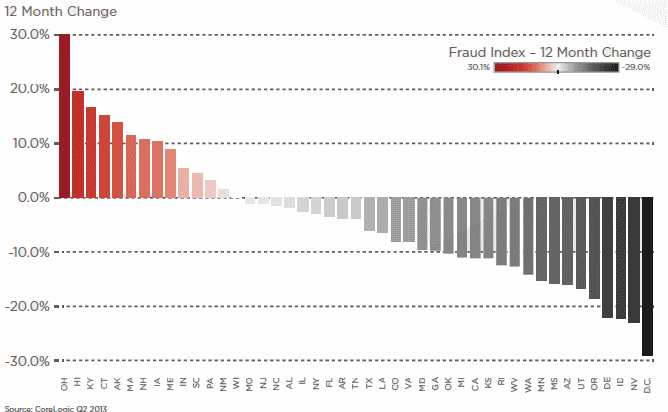Incidents of mortgage application fraud identified in the second quarter were less likely to be property related and more likely to be tied to income information than they were the year before CoreLogic said today. The company released its quarterly Mortgage Fraud Report showing overall application fraud risk down, and fraud related to property information down by one-fifth since the same quarter in 2012. At the same time, application fraud related to income and to debt both increased, especially the former.
Mark Fleming, chief economist for CoreLogic, said, "As the housing market and economy have healed over the last 18 months, a transition away from property-related to income-related application fraud has occurred. Rising prices and a healing housing market make property-related mortgage application fraud less likely, but a higher level of scrutiny on an individuals' ability to pay increases the propensity to attempt income-related fraud."
CoreLogic's analysis indicates that about 19,700 mortgage applications filed in the second quarter had some risk of fraud. This is a rate of 0.8 percent and is down from 20,900 applications or 0.7 percent a year earlier. Little change was noted from the first quarter of 2013. The dollar value of applications identified as having a risk of fraud declined 5.6 percent from the second quarter of 2012 to a total of 5.3 billion compared to $5.5 billion a year earlier. Application fraud was up slightly from $5.2 billion in the first quarter of 2013.

CoreLogic categorizes mortgage application risk using six specific indexes; income, occupancy, employment, identity, property and undisclosed debt. Among these, intentional misrepresentation of income increased by 13.3 percent from the second quarter of 2012 and 7.5 percent from Q1. Property fraud risk, the deliberate over- or under-valuing of a home, had a 7.1 decrease from the first quarter of 2013, contributing to the 20.8 percent year-over-year decline.
Identity fraud occurs when an applicant creates, alters, or steals an identity to obtain a mortgage. It also fell substantially, down 14.5 percent and 3.2 percent from the previous year and quarter. Undisclosed debt increased by 2.1 percent on an annual basis and 0.2 percent from the first quarter. Employment fraud, that is intentionally misstating the name of an employer, position, or duration of employment, was unchanged year-over-year but up 1.5 percent from the first quarter. Occupancy application fraud, misstating one's intention to live in a property in order to obtain a benefit, increased 0.7 percent on an annual basis but was up 2.6 percent in a single quarter.

Fleming said that since the beginning of 2012 application fraud risk has totaled more than $30 billion nationally. "While the propensity toward application fraud risk has declined based on our index, as the housing market recovers, the volume of mortgage applications is rising and increasing the total amount of fraudulent mortgage loan application dollars."
The dollar volume of fraudulent mortgage applications decreased quarter-over-quarter in 27 states and increased in 13 states compared to a year earlier. Ohio had the highest year-over-year growth in mortgage application fraud risk at 30.1 percent, followed by Hawaii (19.6 percent), Kentucky (16.6 percent), Connecticut (15.0 percent) and Alaska (13.8 percent.)

Of the 75 Census Bureau areas analyzed, Allentown-Bethlehem-Easton, Pa. had the highest year-over-year increase in mortgage application fraud risk at 33.6 percent, followed by Honolulu, Hawaii (27.4 percent), Greenville-Mauldin-Easley, S.C. (26.8 percent), Rochester, N.Y. (22.9 percent) and Bridgeport-Stamford-Norwalk, Conn. (22.5 percent).







